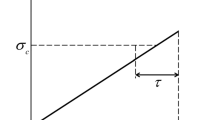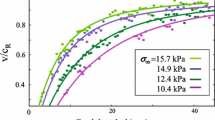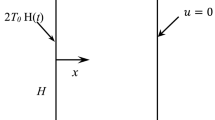Abstract
This paper presents a computational analysis and several simulations of an existing experiment, which deals with a quasi-static thermal crack propagation in a glass plate. The experimental observation was that a straight or oscillatory crack propagation occurred depending on the plate width and thermal loading. The goal here is to simulate this experiment with the recent numerical tool such as XFEM. First, the analysis of the settings of the experiment is developed by providing the computed energy release rate of the crack for a wide range of experiment settings parameters. Second, different crack propagations are simulated, and show a good agreement with the experimental observation of straight or oscillatory paths. Third, a study of the results given by the fracture criteria (maximum hoop stress and Local Symmetry criteria) is also presented for this particular experiment in order to evaluate their differences.
Similar content being viewed by others
Abbreviations
- \({a, \dot{a}}\) :
-
Crack length and velocity
- t :
-
Time
- T :
-
Temperature
- \({{\underline{\underline{\sigma}}}}\) :
-
Stress tensor
- \({{\underline{\underline{\varepsilon}}}}\) :
-
Strain tensor
- \({\mathbb{C}}\) :
-
Linear elastic behavior law
- \({\underline{\underline{I_d}}}\) :
-
Identity matrix
- K1, K2:
-
Stress intensity factors
- θ c :
-
Crack angle
- G :
-
Energy release rate
- α :
-
Coefficient of thermal expansion
- ρ :
-
Density
- E :
-
Young’s modulus
- ν :
-
Poisson’s ratio
- k :
-
Thermal conductivity
- D :
-
Thermal diffusivity
- c p :
-
Specific heat capacity
- c r :
-
Rayleigh wave speeds
- K Ic :
-
Fracture toughness
- G c :
-
Critical energy release rate
- z :
-
Vertical position of the crack tip
- T hot :
-
Temperature of the oven
- T cold :
-
Temperature of the water
- ΔT = T hot − T cold :
-
Temperature difference
- V :
-
Dipping velocity
- h :
-
Distance water-oven
- w :
-
Plate width
References
Adda-Bedia M, Arias R, Ben Amar M, Lund F (1999) Generalized Griffith criterion for dynamic fracture and the stability of crack motion at high velocities. Phys Rev E 60(2): 2366–2376
Adda-Bedia M, Pomeau Y (1995) Crack instabilities of a heated glass strip. Phys Rev E 52: 4105
Amestoy M, Leblond JB (1992) Crack paths in plane situations–II. Detailed form of the expansion of the stress intensity factors. Int J Solids Struct 29(4): 465–501
Attigui M, Petit C (1997) Mixed-mode separation in dynamic fracture mechanics : New path independent integrals. Int J Fract 84(1): 19–36
Bahr HA, Fischer G, Weiss HJ (1986) Thermal-shock crack patterns explained by single and multiple crack propagation. J Mater Sci 21(8): 2716–2720
Bahr HA, Gerbatsch A, Bahr U, Weiss HJ (1995) Oscillatory instability in thermal cracking: a first-order phase-transition phenomenon. Phys Rev E 52(1): 240–243
Belytschko T, Black T (1999) Elastic crack growth in finite elements with minimal remeshing. Int J Numer Methods Eng 45(5): 601–620
Belytschko T, Liu WK, Moran B (2000) Nonlinear finite elements for continua and structures. Wiley, Chichester
Belytschko T, Moës N, Usui S, Parimi C (2001) Arbitrary discontinuities in finite elements. Int J Numer Methods Eng 50(4): 993–1013
Buckingham E (1915) The principle of similitude. Nature 96(3): 396–397
Corson F, Adda-Bedia M, Henry H, Katzav E (2009) Thermal fracture as a framework for quasi-static crack propagation. Int J Fract 158: 1–14
Cotterell B, Rice JR (1980) Slightly curved or kinked cracks. Int J Fract 16(2): 155–169
Deegan RD, Chheda S, Patel L, Marder M, Swinney HL, Kim J, de Lozanne A (2003) Wavy and rough cracks in silicon. Phys Rev E 67(6): 66209
Erdogan F, Sih GC (1963) On the crack extension in plates under plane loading and transverse shear. J Basic Eng 85: 519–527
Ferney BD, De Vary MR, Hsia KJ, Needleman A (1999) Oscillatory crack growth in glass. Scripta materialia 41(3): 275–281
Freund LB (1972) Crack Propagation in an elastic solid subjected to general loading. Pt. 1. Constant rate of extension. J Mech Phys Solids 20(3): 129–140
Gol’dstein RV, Salganik RL (1974) Brittle fracture of solids with arbitrary cracks. Int J Fract 10(4): 507–523
Griffith AA (1921) The phenomena of rupture and flow in solids. Philosophical transactions of the royal society of london. Series A, containing papers of a mathematical or physical character, pp 163–198
Hakim V, Karma A (2009) Laws of crack motion and phase-field models of fracture. J Mech Phys Solids 57(2): 342–368
Katzav E, Adda-Bedia M, Arias R (2007) Theory of dynamic crack branching in brittle materials. Int J Fract 143(3): 245–271
Katzav E, Adda-Bedia M, Derrida B (2007) Fracture surfaces of heterogeneous materials: a 2D solvable model. EPL (Europhys Lett) 78: 46006
Kilic B, Madenci E (2009) Prediction of crack paths in a quenched glass plate by using peridynamic theory. Int J Fract 156(2): 165–177
Marder M (1994) Instability of a crack in a heated strip. Phys Rev E 49(1): 51–54
Menouillard T, Elguedj T, Combescure A (2006) Mixed mode stress intensity factors for graded materials. Int J Solids Struct 43: 1946–1959
Menouillard T, Réthoré J, Combescure A, Bung H (2006) Efficient explicit time stepping for the eXtended Finite Element Method (X-FEM). Int J Numer Methods Eng 68: 911–939
Menouillard T, Réthoré J, Moës N, Combescure A, Bung H (2008) Mass lumping strategies for X-FEM explicit dynamics: application to crack propagation. Int J Numer Methods Eng 74(3): 447–474
Moës N, Dolbow J, Belytschko T (1999) A finite element method for crack growth without remeshing. Int J Numer Methods Eng 46(1): 131–150
Needleman A (1987) A continuum model for void nucleation by inclusion debonding. J Appl Mech 54: 525
Pham VB, Bahr HA, Bahr U, Balke H, Weiss HJ (2008) Global bifurcation criterion for oscillatory crack path instability. Phys Rev E 77(6): 66114
Pla O (1996) Modelling fracture driven by a thermal gradient. Model Simul Mater Sci Eng 4(2): 193–202
Reddy KPR, Fontana EH, Helfinstine JD (1988) Fracture toughness measurement of glass and ceramic materials using chevron-notched specimens. J Am Ceram Soc 71(6): 310–313
Rice JR (1968) A path independent integral and the approximate analysis of strain concentration by cracks and notches. J Appl Mech (Trans ASME) 35: 379–386
Ronsin O, Heslot F, Perrin B (1995) Experimental study of quasistatic brittle crack propagation. Phys Rev Lett 75(12): 2352–2355
Ronsin O, Perrin B (1997) Multi-fracture propagation in a directional crack growth experiment. Europhys Lett 38(6): 435–440
Ronsin O, Perrin B (1998) Dynamics of quasistatic directional crack growth. Phys Rev E 58(6): 7878–7886
Sasa S, Sekimoto K, Nakanishi H (1994) Oscillatory instability of crack propagations in quasistatic fracture. Phys Rev E 50(3): 1733–1736
Yang B, Ravi-Chandar K (2001) Crack path instabilities in a quenched glass plate. J Mech Phys Solids 49(1): 91–130
Yoneyama S, Sakaue K, Kikuta H, Takashi M (2008) Observation of stress field around an oscillating crack tip in a quenched thin glass plate. Exp Mech 48(3): 367–374
Yuse A, Sano M (1993) Transition between crack patterns in quenched glass plates. Nature 362: 329–331
Author information
Authors and Affiliations
Corresponding author
Rights and permissions
About this article
Cite this article
Menouillard, T., Belytschko, T. Analysis and computations of oscillating crack propagation in a heated strip. Int J Fract 167, 57–70 (2011). https://doi.org/10.1007/s10704-010-9519-0
Received:
Accepted:
Published:
Issue Date:
DOI: https://doi.org/10.1007/s10704-010-9519-0




